Silver Outperforming Gold in Latest Leg of Bull Market - Weekly Wrap Up

Did you know you can get the Sprott Money Weekly Wrap Ups, Ask The Expert,
special promotions and insightful blog posts sent right to your inbox?
Sign up to the Sprott Money Newsletter here.
Silver is up 1% on the week, holding above $26, and at this point looks better than gold. With that in mind, host Craig Hemke sits down with silver expert David Morgan of The Morgan Report to break down all the gold and silver news you need to understand where we are in the bull market.
In this edition of The Weekly Wrap-Up, you’ll hear:
- What it will take to extend the rally?
- The impact of Fed policy on the precious metals
- Plus: The right way to look at a CoT report
“In the big, big picture… it’s that we’re in the final leg of a major secular bull market that started roughly in 2003 for silver and 2000 for gold. If you read Jimmy Rogers’ books on commodities, he’ll tell you that the average commodities cycle is about seventeen years. So we’re probably—basis that and my own work—near the final chapter of this bull run. In the final chapter, though, third leg up, silver outperforms gold.”
To hear David’s full thoughts on this week’s gold and silver news, listen here:
Man: You're listening to the "Weekly Wrap-up," on "Sprott Money News."
Craig: Happy Friday from Sprott Money News at sprottmoney.com. It's Friday, March the 19th, 2021. It's time for your "Weekly Wrap-up." I'm your usual host, Craig Hemke. Joining us is a first-time guest subbing in for Eric and that's David Morgan. Many of you are familiar with David, of course. He's devoted almost his entire adult life to silver and following silver and understanding the silver market. So he is definitely a silver expert. He's the publisher of "The Morgan Report." His work can be found at themorganreport.com. And I feel myself fortunate to consider him a friend. David, thank you so much for joining me today.
David: Well, Craig, thanks for inviting me.
Craig: Well, we'll have some fun here, my friend. Let's get a little bit of business out of the way. First and foremost though, we've got to remember, everyone, please, all of this information that's provided by Sprott Money, whether it's the weekly articles that you can find on the site, whether it is the "Ask The Experts" segment, which was just posted yesterday with Tavi Costa of Crescat Capital in Denver. Tavi is a great macro and precious metals analyst. You want to be sure to go to sprottmoney.com and find that interview, but also these weekly wrap-ups, they're all brought to you by sprottmoney.com. If you have bullion storage or bullion acquisition needs, it's the first place you need to check.
And at present, we are still running the Sprott Signature Sale. But that sale ends at midnight tomorrow night. Midnight, Saturday night. So the window of opportunity is close to closing. So please go there and check out our signature sale prices. Of course, this website's sprottmoney.com, and you can always talk to an actual human being by picking up the phone at (888) 861-0775.
David, as we record this, silver's actually up 1% on the week. Looks to be holding again above that important $26 level. It seems to be leading maybe gold. Certainly, the chart looks better than gold. The silver miners look better than the gold miners at this point. What are your thoughts? Let's just focus on silver. What are your thoughts?
David: Well, on the big, big picture, Craig, it's that we're in the final leg of a major secular bull market that started roughly in 2003 for silver, and 2000 for gold. If you read Jimmy Rogers' books on commodities, he'll tell you that the average commodity cycle's about 17 years. So we're probably, basis that, and my own work, near the final chapter of this bull run. In the final chapter, the third leg up, silver outperforms gold. And so far, that's come to fruition. We saw silver about a year ago in March hit the $12 handle. Believe me, you couldn't buy silver at $12. I actually bought the day before it hit $12. And I bought a fair amount. And the next day, it dropped, like, 2 bucks from roughly $14 to that $12 on the paper markets.
I called my dealer and I said, "How bad did I do it to myself? And he said about 50 cents. So, in the retail market, I wasn't buying off the COMEX, in the retail market, you know, it was pennies, really, because even though it was a $2 move in the paper market, the actual physical market for large retail investors, really hadn't moved that much. So, I digressed to come back. But the idea is this: silver outperforms in the last leg, it is leading, and that's exactly what it's supposed to do. So that's basically a confirmation to me that I'm correct about where we are in the overall grand scheme of the precious metals markets.
Craig: What do you think of this bifurcation of price? You know, you mentioned that from last year, where the paper got to $12 but it was hard to find it anywhere less than $20, and it seemed like eventually price kind of came and met in the middle. The paper price rose, and the premiums kinda went back down by summertime, and then price took off. Here we are again, you know, where maybe the paper price is $26 but it's hard to find it for less than $36. Do you think those prices have to get a little closer together, you know, before we can extend the rally?
David: I do. I mean, as you well know, Craig, and I'm sure most of the audience, it's, you know, an arbitration opportunity, you can arbit. You can say, "Send me that $26 silver off of the COMEX." You know, punch it out into rounds, and sell it for $33 or whatever. So that's an opportunity, especially at scale. Of course, before anyone does that, you know, there's capital costs to find someone to, you know, punch out the blanks for you and stamp them, and there's costs involved, transportation, everything else. But any arb like that, it does eventually net down to where they're basically much, much closer together.
I think that will happen again. When it happened in 2008 during the financial crisis, I wrote an article about it. And some of my followers weren't happy with what I said, but I turned out to be correct. And I'm not 100% correct. I think most people know that. But what I said was the price of the retail will come toward the futures price, and it did. So, those 30% premiums, sometimes higher on eBay, actually did come down and be more in line with what the standard markup is from the spot market into the retail market. Will that happen again? And, of course, from history, I'd have to say yes. But Craig, I want to state for the record, I'm not so sure this time. Why, David?
Because we're seeing a markup on the commercial bars. We're seeing, you know, anywhere from, like, a quarter to 50 cents to...offloading, where you actually take the bar, and maybe do what I just suggested. You know, that's, like, a dollar because, you know, it's delivery. It's not just taking the warrant and moving it from one pile to the next. So, you know, when I quote these prices on commercial bars, I need to be explicit, because we have our critics, and that's okay. It sharpens you and makes you think a little deeper and explain a little bit more why, you know, 50 cents might be what you pay just to retag it. But, $1, $1.25 in some cases, might be what you'd pay to go down there and stick it in the back of your pickup truck and take off with, you know, your property.
Craig: It is an interesting time to be alive. No doubt about it. And the way this year has begun, with kind of this consolidation, at least in the gold price, and silver kind of going sideways still, up, I think, actually, silver, year-to-date, maybe is down 1%, something like that. Much better than gold. You know, where everybody's paying close attention to the Fed and what they might do next. And obviously, the bond market's important as well. You know, we collect questions at Sprott Money each week for the guest on these "Weekly Wrap-up," podcasts. The email address is submissions@sprottmoney.com. And we had a couple of questions this week, David, regarding fed policy and the bond market, and the impact on the precious metals. You wanna just kind of take that topic in a broad sense and give us your thoughts?
David: Sure. Okay. Well, first of all, inflation, I mean, as an adherent to the Austrian school, any increase in the money supply is inflation, by definition. You've created more. Now, the argument gets to, and you can say that, you know, you can have a different opinion. I mean, I think that's a fact. If you increase the supply of something, it's gone up, which means the value of all the remaining units goes down eventually. There's arguments that it's sterile, that it's in long-term and short-term treasuries, that it's sitting in a safe and not used, it's re-liquefying the banks, and there's very little velocity. And then there's even arguments about if velocity is meaningful or not. I would argue that it is.
I mean, if all that money got created, and then once it was created, it was burned, the velocity would be absolute zero forever, so it would have no meaning. But regardless of it... We are having inflation, and it is out there. This is, I think, my pet peeve about it. You know, if you take out food and energy, you can keep inflation under 2%, and the Fed keeps saying, "Oh, we're striving to get inflation to 2%." Well, put food and energy back in there, like you did in the 1980s, and let's see where the inflation rate is.
So there's that. That's probably the most common-sense, easiest approach. As far as the bond market, I think we're in trouble. I've been looking for a top in bonds for a long time, and I've missed it a few times. I've just done a couple wimpy option trades. I don't like to get long and strong until I'm sure the trend is there. But I didn't check the 10-year this morning, Craig. You might tell me, I don't know if we're near 2% or not.
Craig: About 1.75%.
David: Okay. So, I'm going to talk a little bit there, because I think it's the most important thing. It's actually more important to me than silver and gold, because the debt markets basically are the keys to the kingdom. Everything revolves around the credit markets. So, this is from Lee Adler. One of my hedge fund buddies of mine pointed out his work to me. And so, I'll just go through it real quick. What he's saying here in this article, which is pretty easy to understand if you read it a couple times. The yield at the time he wrote this was %1.72, and everybody's watching the yield and associate it with inflation fears. Oh, that's all well and good, but irrelevant and immaterial, ladies and gentlemen of the jury. What is happening is forced selling.
Wall Street always wants to impute meaning to a market, but what is actually happening is forced selling. A crunch, a crash, collapse. Collateral calls to dealers, and margin calls to leveraged longs. The problem is the dealers. They've been weakening to the point of becoming little more than straw parties, acting as conduits for the Fed's feeding $200 billion a month into the markets. Now, I agree with them. If you look at the officials, they'll tell you it's $120 to $80 billion a month. That's sort of like what the national debt is. You know, it shows $20 trillion, but there's $20 trillion, or $21 trillion, that Dr. Skidmore shows is blacked out and then they even made a law that you can't even investigate it.
Same thing here. The rollover in the credit markets on a monthly basis is probably around $100 billion. But they don't talk about that. That's just what's rolled over all the time. So anyway, it is around $200 billion a month. Yes, $200 billion. Excuse me. The media isn't counting everything the Fed pumps in. I just explained that. The question is how much contagion and collateral damage in other asset classes will be necessary before the Fed is moved to emergency measures? Let me hand it back to you, Craig, because off the recording, we talked about that. What do you think the next measure would be, and do you think it'll work?
Craig: Yeah. Well, that's what we're all expecting is some type of stated yield curve control. They won't just come out in one meeting and go right there directly. They'll take baby steps and try to jawbone some type of yield cap. And then we, obviously, didn't get any hint of that. In fact, Powell this week dodged it with the skill of, you know, a premier politician when that question came up. I mean, he said a lot, and then managed to say absolutely nothing. And so, David, you know, you mentioned losing control of the bond market and rates spiking. They simply can't afford that. I mean, first, you know, it'll eventually lead to a stock market collapse. It's deflationary.
You know, you pass those debt service costs on, not only from the federal government but to every level of government, and every level of the private sector. And the last time we got to 3% in the 10-year, that's exactly what happened, and forced the Fed to reverse policy in late 2019. So they have to head that direction, David, but what we don't know is what you mentioned. What is that, the point of maximum pain that will stop them from being just simply reactive, and be more proactive in capping those rates? What's that point?
David: Yeah, it's probably pretty close. I think that 2% that we saw before at that date will be tested, and if it busts through, and, you know, I'll just add on to what you said, which is revivifies it, the last paragraph of this is, "Stay tuned for a yield control and infinite QE. Coming soon to a trading screen near you."
Craig: Yeah. Well, what do you think of this, David? I've been telling folks on my site, I watched, couple weeks ago, the yield curve control, let's call it plans, programs, whatever, of the Bank of Australia and the Bank of Japan. Rates moved up through their caps. And that's when it dawned on me. I mean, this is the, like, the tool of the last resort. Powell talks about his tools and his toolbox. This is the last one, because if they say we're not going to allow 10-year to go past 2%, and the 10-year goes past 2% anyway, then what do they do?
David: Precisely. And I'm a big believer, I think it was you that said it. I'll give you credit, Craig. I think it was you that said that there is a, not natural law, but there's mother nature of the financial markets or something along those lines.
Craig: That was old Andy Hoffman. Remember him? That was his line.
David: Yeah. Okay. But it's true. I think as much control as these control freaks think they have, the market does have a mind of its own. And once you get over that, you know, the dam starts to, you know, crack, and once that water starts seeping through hard, and once it cracks open and starts pouring out, look out. You cannot stop the flood. And I think that's a good analogy for what could happen, and I think it will happen. And that's when you get this liquidity squeeze that bonds aren't safe, what is? Oh, yeah. It's a four-letter word. Let me think for a minute, Craig. It's coming to me. Oh, gold.
Craig: Fold? Bold? Cold?
David: Yeah, Gold. Gold is no counterparty risk if you own it. Now, let's... We could get into that. But so let me pause there, because I'm getting excited, but it's scary in a way. Look, I'm the last one that wanted to see this happen. I was, you know, one of the few in the early days that said, "Let's fix it now before it gets to where it is." But nah, they don't want to listen to cranks like me, so...
Craig: No, not just some cranky old guy out in the woods like you. You weren't the Unabomber, were you?
David: No, not...
Craig: Okay. I just wanna make sure. All right. One last question, David. We had a couple of people write in this week with questions about the Commitment of Traders report. In my view, it's never something you can trade off of. I mean, it's just kind of like a general, it's like a weather vane, a little bit, maybe. You know, if you're going to do a weather forecast, you gotta know which way the wind's blowing, but you also might want to look outside, see if it's cloudy, check the barometric pressure. There's a lot of things that go into it. The Commitment of Traders report, though, when people look at it, can you explain to folks how it's actually kind of, you have to look at it from a contrarian sense, in the fact that when the large speculators get extra bullish, like hedge funds, and their position reaches the higher levels of, you know, what we've seen historically in terms of being net long contracts, that that's actually a contrarian indicator.
And then when they get a smaller position, that's actually bullish. Can you just, in your own words, kind of explain that relationship for folks, because that was what some of the questions dealt with.
David: I'll do my best. So let me just preface it with the best thing to do if you're really interested in this would be to go to a search in and type in "how to interpret the Commitment of Traders reports." I haven't looked at it in a couple years, but there are a couple sites out there that do a fairly decent job of an overview of it. On top of that, I'm going to disagree with you slightly, Craig. First of all, I agree with what you said about it's a barometer, it's not a thermometer. You can't trade off it anymore. But there was a day back when you could. It was before the ETFs. It was before the foundation of the SLV.
Once the SLV came on board, it was much less accurate as far as timing. But back in the day, I did a workshop at the Silver Summit, like, the third year that we had it, and you could trade almost to the nickel, it was that accurate, because it was a constant. You knew how many contracts could be bought before the trading funds ran out of money. And once they ran out of the money, they got flushed out and the game started over. In fact, I got a guy from the floor that wrote me. I may still have the letter. I printed it out, but who knows where it's at. But he complimented me on, you know, what I had said at one of my lectures. And he said, "That's it. You got it. You nailed it. That's how it works, and get ready. It's going to keep happening again and again and again."
So, a couple more comments. One is, you know, we get to the delivery month and everyone gets excited and I've seen that over and over. And, you know, in theory it'd work. I mean, someone as prestigious as Kyle Bass said, you know, if any, you know, 5%'s up for delivery, game over. And now, everyone that says that's correct. The problem is that about 99% of the time, these guys roll their contracts. So what they do is they play the paper game. And then another problem is understanding what these notices mean. Notices are just a notice that you might do something. It's like an invitation to a wedding, but it doesn't mean you're going to show up.
And even if you go past first notice day, and I've done it, so I speak with some authority, you can actually sell back in the paper market anyway. So, it's really difficult to determine what's really going on. We know that it's getting swapped back and forth. We also know very little moves off the COMEX, but earlier in our discussion, Craig, when we were talking about the physical market and the markup in the commercial bars, I wanted to point out that John Adams from Good As Gold Australia, and he and I are starting to have a bit more of a conversation. And I think it's something like 30 million ounces, 28, somewhere in that range, has come off the COMEX in the last, like, four to six weeks.
This is something that's really to keep your eye on, because sort of the place of last resort to get it. So, back to the Commitment of Traders, I haven't lost the idea. The commercials are the banks. Bullion banks and commercial banks. And they have infinite money. They can, you know, get it, print it, whatever. So it's like at a poker game. If you're playing against somebody and you've got 100 chips and they've got 10,000, odds are pretty much in their favor. So what happens is the funds go long, long, and longer, and longest, and they're out of money, just like back in the early days I mentioned. Once they're out of funds, they can't do anything except sell. They're done.
These are usually managed funds that have 2% allocation in the silver market, 3% to corn, 5% to cotton, or whatever. So it's not just people that are playing the silver market. These are managed funds. Some are hedge funds that are metals only, but that's rare. Anyway, they're done. You know, you can't put in any more money. So, the banks know that. And once they get there, the longs may have, on paper, a profit on some of their trades. But once they reach that point and have to sell to take a profit, guess what happens, Craig? I'll bet you know. The banks sell on top of them. So now you've basically got two sales, the specs, or the trading funds, are selling to take a profit, the banks are selling on top of them, which means all trades have to match, which puts on a lot of selling pressure. And the match, maybe somebody out there in the public that says, "You know, when silver was pushing toward $30, boy, I really wish I could buy it at $27.50," and they get their fill, because they got their wish. And then it goes down to $26.50, and they're stopped out.
So, this is the basics of it. There's a little more to it, but you don't have to make it super complicated. And it's the banks that control the books. And what's so infuriating to me is not just what I described, and kind of like, that's normal and it's natural, and it happens in all markets and all the stuff that you hear, but that it is basically against their own printed contract format, or let's just call it the rules. There are rules... You know, nothing I said that's been done that's illegal or against the rules except the size. And this is where we have these concentrations where, you know, that one guy with the, you know, 10 million poker chips and you've got 100. You're a trading fund. You're representing a bunch of investors that want to be in the commodities markets, and it's unfair. And it's in the rule book. And yet it's overlooked again and again and again.
Craig: And again, and again, and again. No doubt about that. You know, and what's also frustrating is that the speculators are just making a bet. You know, they want to be long commodities, and so it gets spread out, or they think that, you know, one of these...you're betting against the dollar or whatever like that. None of that, very, really, rarely, any of that has anything to do with physical supply and demand.
David: Yeah. It's all paper.
Craig: It's just gambling. Yeah.
David: Well, I did a real quick back-of-the-envelope, and I could be wrong, maybe you'd like to back me up some point. It's just a what-if. But I thought, you know, what would it be like to see all of that margin money that went into the silver market over 20 years, that went into the physical market? What would that have done to the market? It's pretty astronomical what would happen.
Craig: Yeah. No doubt about it. All right. Well, David, thank you so much. I want to remind everybody, you can find more from David through "The Morgan Report," and you can find it at themorganreport.com. He's been dedicated his whole adult life to this. So nobody that I know of is a greater expert in silver than David. And, of course, if you're looking to acquire some silver, you gotta go to sprottmoney.com. We've got silver in stock, we've got gold in stock, and we've got a place for you to safely store it, too, if you buy enough in size. That is, of course, found at sprottmoney.com and at (888) 861-0775.
And please do us a favor on the way out. If you enjoy these podcasts, please give us a like, or even subscribe to the channel that you're listening to, so we can continue to get the word out. David Morgan, thank you so much for your time. It's been fabulous talking to you. And at this point, I'll wish you a fine weekend.
David: I wish you the same, Craig. Thank you for having me.
Craig: And from all of us at "Sprott Money News" at sprottmoney.com, thank you for listening. We'll talk to you again next Friday.
Don’t miss a golden opportunity.
Now that you’ve gained a deeper understanding about gold, it’s time to browse our selection of gold bars, coins, or exclusive Sprott Gold wafers.
About Sprott Money
Specializing in the sale of bullion, bullion storage and precious metals registered investments, there’s a reason Sprott Money is called “The Most Trusted Name in Precious Metals”.
Since 2008, our customers have trusted us to provide guidance, education, and superior customer service as we help build their holdings in precious metals—no matter the size of the portfolio. Chairman, Eric Sprott, and President, Larisa Sprott, are proud to head up one of the most well-known and reputable precious metal firms in North America. Learn more about Sprott Money.
Learn More
You Might Also Like:




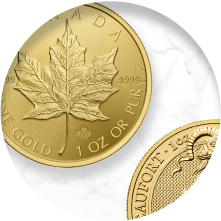

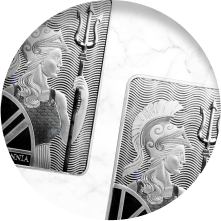

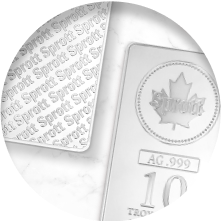

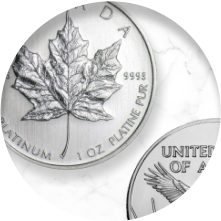

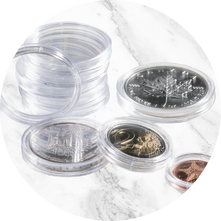
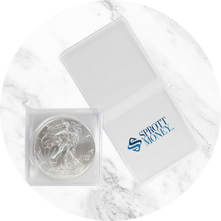



Looks like there are no comments yet.